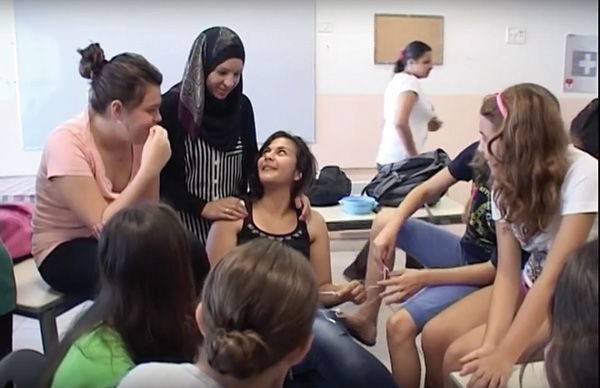Israeli schools build bridges between Jews and Arabs
Published February 15, 2017
Rebecca Bardach and her husband, Eliot Goldstein, grew up on opposite coasts — she in Berkeley, Calif.; he in Silver Spring, Md. — attending a combination of Jewish day and public schools. After each made aliyah in the late 1990s and married, they figured they would send their future children to a progressive day school in Jerusalem, where they had settled.
But before any kids were in the picture, they heard about a different kind of school, one attended by both Jewish and Arab children. “This was an appealing option,” said Bardach, who was in St. Louis recently to talk about the school and meet with potential donors.
“I felt that our children would have a strong sense of Jewish identity, given our backgrounds and where we live,” she continued. “I was more worried about how they would relate to the rest of the world, how they would relate to Arabs. When you grow up in fear and tension and conflict, how do you raise your kids so they see Arabs as friends?”
ADVERTISEMENT
Eventually Bardach and her husband had three children, who are now in fourth and third grades and kindergarten. All three attend Hand in Hand, a nonprofit organization that creates integrated and bilingual Jewish and Arab schools in the hope of forging a more cohesive Israeli society. Begun in 1998, Hand in Hand is currently in six locations in Israel — Jerusalem, the Galilee, Wadi Ara, Jaffa, Haifa and Kfar Saba — and has a total of 1,578 Jewish and Arab students.
Bardach, who now works for Hand in Hand as its director of resource development and strategy, explained that the Israeli public school system has three tracks — Jewish/secular, ultra-Orthodox and Arabic. While Arabs can attend Jewish schools and vice versa, she said the vast majority of Arabs attend Arabic schools, as Jews attend Jewish schools.
“That totally reflects the major community groups and their preferences,” said Bardach. “People live separately. They go to school separately and are doing extra-curricular activities separately.
ADVERTISEMENT
“When you add to that the ongoing conflict, tension, fear and language barriers, it means you are only adding layers rather than pulling them away and trying to figure out how to promote co-systems.”
Bardach said parents who choose to send their children to Hand in Hand are making a very deliberate choice. “They are very intentional in saying I want a different school for my kids. I want a different option for society. I want to be part of creating an alternative.”
She noted that Hand in Hand schools are public, and get the same amount of state funding as every other public school in Israel. However, because of the schools’ multi-cultural model — all students study Jewish, Muslim and Christian traditions and all classes require two teachers, one who speaks Hebrew, the other Arabic — Hand in Hand charges a tuition fee of 5,000 shekels, or roughly $1,200. Scholarships are available for those who cannot afford the tuition.
Bardach said Hand in Hand hopes to open 10 to 15 more schools over the next 10 years. The plan is to be in every region of the country where Jews and Arabs live together. “Our goal is strong, vibrant, integrated schools that champion this partnership,” said Bardach. “While we have high demand and waiting lists where we currently operate schools, we want every city in Israel to have this as an option. It’s mostly a matter of getting the municipalities on board and securing the philanthropy needed.”
Philanthropy was one of the reasons Bardach visited St. Louis. The Jewish Federation here has supported Hand in Hand for three years, ever since Stephen Cohen, vice president of planning & allocations at Federation, read about the school in the Jerusalem Post and was looking to fund programs in Israel that supported co-existence.
Interestingly, the rise in demand for Hand in Hand followed an arson attack in 2014 against the school in Jerusalem by three members of the far-right Lehava group, which works to prevent intermarriage and coexistence between Jews and Arabs in Israel. Arsonists torched two first-grade classrooms and spray-painted racist graffiti such as “Death to the Arabs” and “Kahane was right,” referring to the late Rabbi Meir Kahane, an organizer of the Jewish ultra-nationalist movement.
“We had had graffiti incidents on the outside of the school, but never the inside,” said Bardach.“But as people heard about what had happened, they began showing up. In less than 12 hours we had 630 parents, children and teachers cleaning up and making signs that said, “Hand in Hand Refuses to be Enemies.’
“By the next morning (when school resumed), hundred of people, including the mayor, police and firefighters participated in a solidarity rally. It was a huge outpouring, and with that, people had a total turnaround. One father said, ‘This school is the iron dome around the hatred among us.’ The (arson attack) really helped people recommit to what we are trying to create and we have had real growth since then.”
For more information go to handinhandk12.org
















